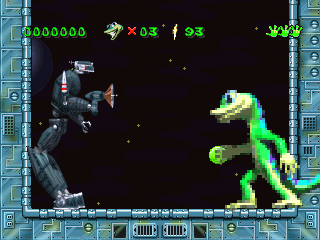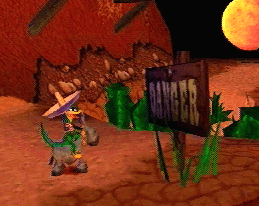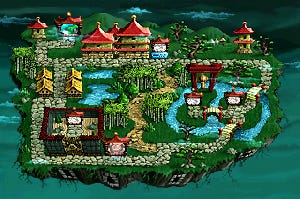The Hard-Tail Times of Gex: A Post Mortem on 21 Months of Chaos
How a scrappy team, misaligned expectations, and hidden features turned one of the 90s' wildest dev stories into a delivery management case study
“GEX was one of those projects from Hell.” — Gregg Tavares
I couldn’t think of a better way to open this post.
That quote comes from a now-legendary postmortem written by Gregg Tavares, the lead programmer on Gex, Crystal Dynamics’ would-be mascot platformer released in 1995.
Like dozens of other titles from its era, the game was pitched as the next Sonic the Hedgehog, a character-driven blockbuster that could fuel cartoons, toys, and entire aisles of merchandise at Toys “R” Us. What it became, however, was something very different: a chaotic, over-scoped, under-resourced, creatively fragmented project that somehow, through sheer grit and countless 16-hour days, made it to shelves and found success. But at a cost.
What Tavares shared wasn’t just a cautionary tale from ‘90s game development. It was a rare, brutally honest chronicle of what happens when business expectations, creative ambition, and production reality collide without the right structure to hold them together.
As someone with a background in both software and creative teams, I couldn’t read that post without spotting every red flag in the book: poor scope management, misaligned stakeholders, under-staffing, last-minute pivots, hidden side projects, and a total breakdown in team communication.
And yet, Gex shipped. It sold well, and it’s still remembered fondly by many, especially by the author of this post, who has warm memories of playing alongside his mom on the original PlayStation, laughing at every wisecrack from that smart-ass gecko.
So today, in honor of the upcoming Gex Trilogy, let’s revisit that wild 21-month journey from concept to crunch and draw some lessons for anyone building big things under pressure.
Without further ado… lock and load, little lizard!
Phase 1: Marketing-Driven Mayhem
“The design to that point was heavily influenced by marketing. (...) The level intro would show stock footage of old Hollywood western movies (for some reason marketing thought this was the greatest idea ever) and then the level would have Gex going through it doing ‘stunts’.” — Gregg Tavares
Before Gex had a protagonist, a story, or even a working prototype, it had something else: the perfect distillation of mid-90s marketing ambitions.
Crystal Dynamics wanted Gex to be a franchise juggernaut. Visions of lunchboxes, cartoons, and aisles of Gex-branded merchandise permeated the studio’s marketing team long before there was a design document worth shipping. And that fantasy directly shaped the game’s original concept: before Gex being a Media Dimension-hopping gecko, he was “Gecko X,” a Hollywood stuntman saving a failing movie studio, with levels themed around stock footage genres like Westerns and action flicks.
You can probably guess how that went.
As Tavares described, the team quickly discovered that this real-world setting clashed with the logic of 2D platforming. You can’t throw in floating platforms, impossible jumps, or surreal geometry in a dusty cowboy town without breaking immersion. Fantasy games like Mario and Sonic thrive because their rules are flexible — mushrooms grow twice your size, turtles fly, platforms float, and nobody questions it. Realism, especially Hollywood realism, boxed the designers into a corner before they’d even started building. And let’s be honest, trying to be realistic when your protagonist is a gecko stuntman was never going to end well.
The lesson here? Let creators define the sandbox, not marketers. Ambition is great, and mascots sold well at the time, but if your foundation is built on what moves merch instead of what supports great gameplay, you're building a house of cards.
Of course, market data should absolutely inform what kind of game you’re building. Research, trends, and audience insights can help frame the vision and even inspire themes or mechanics. But the scope of action between marketing and development must be clearly defined. Otherwise, constant interference will derail the project before it can find its creative footing.
In other words, creative direction must lead scope, not the other way around.
Fortunately for Gex, the team course-corrected early. They scrapped the Hollywood studio angle, embraced a fantasy-TV world suggested by Tavares, and gave themselves the narrative flexibility to build imaginative levels that actually supported gameplay. This is a great example of how team-driven intervention can rescue projects derailed by early assumptions, a pillar of agile development that would be spread in the following decade.
But as we’ve seen countless times in game development, too many good ideas can inflate scope beyond control. My previous post about Cyberpunk 2077 is a textbook case of what happens when ambition outpaces structure, and Gex was no exception.
As we’ll see next, even a better idea can’t save a project without the right team and proper resources to build it.
Phase 2: The 16-Bit Mindset in a 32-Bit World
“It was clear we needed a much larger team. Unfortunately the company didn’t want to hear it. They wanted a 32-bit game that would be the next Sonic but they were not willing to put the resources into it that would be required to do it.” — Gregg Tavares
As Gex moved beyond its Hollywood origins and embraced a multi-world, fantasy-themed adventure, the team found itself staring down a brutal truth: building for 32-bit systems wasn’t just a graphical upgrade — it was a production leap.
Tavares explained this well in his report. In the 16-bit era, a full set of level graphics could fit on a single 320x200 screen. That meant fewer tiles, smaller asset needs, and leaner teams. But with the arrival of CD-based 32-bit systems like the 3DO and PlayStation, the canvas expanded dramatically. Each Gex level now required six to twelve times the art of a previous-gen platformer. Multiply that by six worlds, each with multiple art sets, and suddenly the math became unavoidable: you either scale your team or sink your schedule.
Unfortunately, Crystal Dynamics leadership tried to do neither.
Despite clear signs that the workload had ballooned, production stuck to old models. A two-artist team (standard for SNES-era games) was expected to deliver next-gen fidelity. Contractors came and went. Some art was discarded. Internal requests to expand the team were denied or delayed. By the team’s own estimates, they needed four to five times the art capacity they had… and didn’t get it until far too late.
The result? Bottlenecks. Burnout. Months of delays. And a wildly uneven production flow that forced design compromises just to keep the game moving.
Here’s the takeaway for today’s teams: when scope increases, resourcing must follow. Sure, we’ve all heard horror stories of bloated teams and ballooning budgets that deliver disappointing results. But in Gex’s case, we’re looking at the opposite problem. New platforms, new pipelines, and new ambitions are both creative opportunities and operational multipliers. Trying to ship a PlayStation 5-level game with a PlayStation 2 headcount and legacy planning habits just doesn’t compute.
And this lesson stretches far beyond gaming. In modern product development, tooling upgrades, backend migrations, or UX overhauls often get greenlit without fully accounting for their downstream impact on delivery. A faster engine means bigger assets. More integrations mean more testing. Better fidelity means heavier pipelines. If your resource model doesn’t evolve with your ambition, what follows is predictable: blown estimates, frustrated teams, and rushed compromises.
And sometimes, as Gex would soon learn, cutting scope becomes not just a smart decision, but an unavoidable one.
Phase 3: Secret Levels and Unofficial Side Projects

“All of this was done in secret without the knowledge of the company, 3 of the 4 designers, and the producer of the game.” — Gregg Tavares
By the time Gex entered its final stretch of development, the mood inside Crystal Dynamics was… complicated, to say the least. Frustration was high. Fatigue had set in. And yet, somehow, pockets of creativity were still alive, just not through official channels.
Faced with delayed timelines, cut features, and top-down decisions that left little room for passion, several members of the Gex team quietly began building entire levels in secret. These included repurposed cut sci-fi assets, bonus minigames, and even an 18-minute secret ending packed with team photos, sketches, and developer shoutouts.
None of this was sanctioned. None of it was scoped. But all of it was done from a place of love, and as a response to a lack of creative agency.
Rogue initiatives rarely come out of nowhere. More often, they’re symptoms of a broken roadmap or fractured trust between teams and leadership. When official pipelines become too rigid or opaque, creative people will find their own ways to express themselves. And when contributors feel unheard, they’ll stop asking for permission.
Now, was this rebellion productive? In Gex’s case, oddly… yes. The secret content was so good, the company decided to leave much of it in the game, including the long-form ending. But relying on shadow work is not a sustainable production model. If your team is shipping more passion through side channels than official ones, something’s gone wrong in your delivery culture.
Creative autonomy should be structured, not suppressed. Innovation thrives in environments where experimentation is planned, reviewed, and welcomed, not hidden like contraband. This is why governance matters, specially with agile teams and in creative fields. Governance isn’t bureaucracy, but a path to visibility, alignment, and a shared sense of what’s allowed, what’s possible, and what gets prioritized.
And when formal leadership can’t create that structure, lateral leadership fills the void. From Tavares’ post, it’s clear that mid-level team members (programmers, designers, even musicians) stepped up, made things happen, and created value beyond the roadmap. That’s a hallmark of great teams: when the org chart fails, trust and initiative still carry the work.
But that’s not how it should have to happen. When your best work is happening off the books, your books are broken. Give people room to create within the system, or they’ll build their own. And while that might work once, it’s not a blueprint you want to bet your next project on.
And speaking of broken books, what happened next is a real ugly case of mismanagement.
Phase 4: The Hidden Message and the Fallout
“Didn’t you think this level had some cool sh*t in it? This level was cut because the company didn’t put you, the customer, first but just wanted to make money.” — Hidden in-game message, discovered late in Gex development
If there’s a defining moment where Gex crossed the line from production chaos into full-on crisis, this was it.
Late in development, designer Justin Knorr inserted a secret message into a hidden level of Gex. It wasn’t a fun Easter egg. It was a direct, scathing critique of the company, accusing it of caring more about money than players, and even encouraging users to call a senior manager at Crystal Dynamics to complain (the message even had her real phone number!).
This wasn’t an isolated outburst, but the culmination of months of miscommunication, last-minute cuts, and ignored creative input. Being checked out of the production and refusing to participate on the crunch time with the rest of the team, Knorr had already seen many of his level ideas shelved or drastically altered to meet deadlines. Then came the final straw: one of his levels was quietly edited over the weekend without his knowledge, in a final push to ship. For him, that was a betrayal. Stripped of creative agency and shut out of key choices, Knorr responded the only way he felt he could: by using the game itself as a platform for protest.
And that’s when the message was discovered by QA.
He was fired on the spot, but by then, the damage had already been done, not just to the team dynamic, but to the company’s internal trust and delivery reputation.
Let’s be clear: this was a serious breach of professionalism. But it didn’t happen in a vacuum. It happened because the systems designed to catch these tensions failed. There were no effective escalation channels. No process for reviewing or explaining top-down cuts. No framework for reconciling creative vision with delivery constraints. And no real room for dissent. Only deadlines.
This is why culture without communication becomes sabotage. When creative teams aren’t heard, they don’t just fall quiet. They find backchannels, get cynical, and if the project is high-profile or the stakes are personal, some will lash out in ways that risk the entire ship. When people stop feeling heard, they stop playing by the rules. Communication isn’t just a nice-to-have, but the foundation that keeps creativity and delivery aligned. If your culture shuts down dissent, don’t be surprised when it shows up where you least expect it.
Knorr didn’t just sneak in a message. He revealed just how broken the studio’s feedback culture had become. And whether you’re building a video game or a SaaS platform, that kind of silence-before-the-storm should never be ignored.
As leaders, it’s on us to make sure frustration doesn’t metastasize. That creators are heard, that decisions are explained, and that feedback is invited. If your team’s only way of speaking up is hiding messages in the product, you lost leadership.
The Game Shipped. But at What Cost?
Gex made it to store shelves in March 1995. It received positive reviews, sold well, and became one of Crystal Dynamics’ early hits. For players, it was a colorful, sarcastic, mechanically solid platformer with a gecko full of one-liners and a lot of charm (at least, it was for me. But I admit that he can be unsufferable at times).
However, for the people who built it, it was 21 months of crunch, misalignment, cut corners, burnout, and unspoken tensions.
This is one of the most important lessons we can take from postmortems like Gregg Tavares’s: shipping is not the same as succeeding. Just because a game is released, and even celebrated, doesn’t mean the delivery process behind it was healthy, scalable, or worth repeating.
The Gex team pulled off a miracle, but miracles are, by definition, unsustainable. They found clever workarounds, took matters into their own hands, and carried the project across the finish line with grit and improvisation. But it came at a cost: creative disillusionment, team fractures, and at least one team member fired in dramatic fashion.
In today’s terms, this is what happens when ambition isn’t matched by process, when marketing drives scope, when resourcing lags behind reality, when communication breaks down, and when governance is seen as a blocker rather than a bridge. And yet, these stories are valuable. Not because they’re rare, but because they’re still happening — in games, in tech, in every industry where creativity meets pressure.
So if you're leading a team, building something ambitious, or just trying to get a complex project out the door, remember: success isn’t just about what ships. It’s about how it gets built.
Let’s keep celebrating wins, but let’s also make sure the people behind them aren’t left burned out, silenced, or stuck fixing last-minute bugs in secret.
Let’s keep building better. And, as always, let’s keep leveling up, one boss level at a time.







